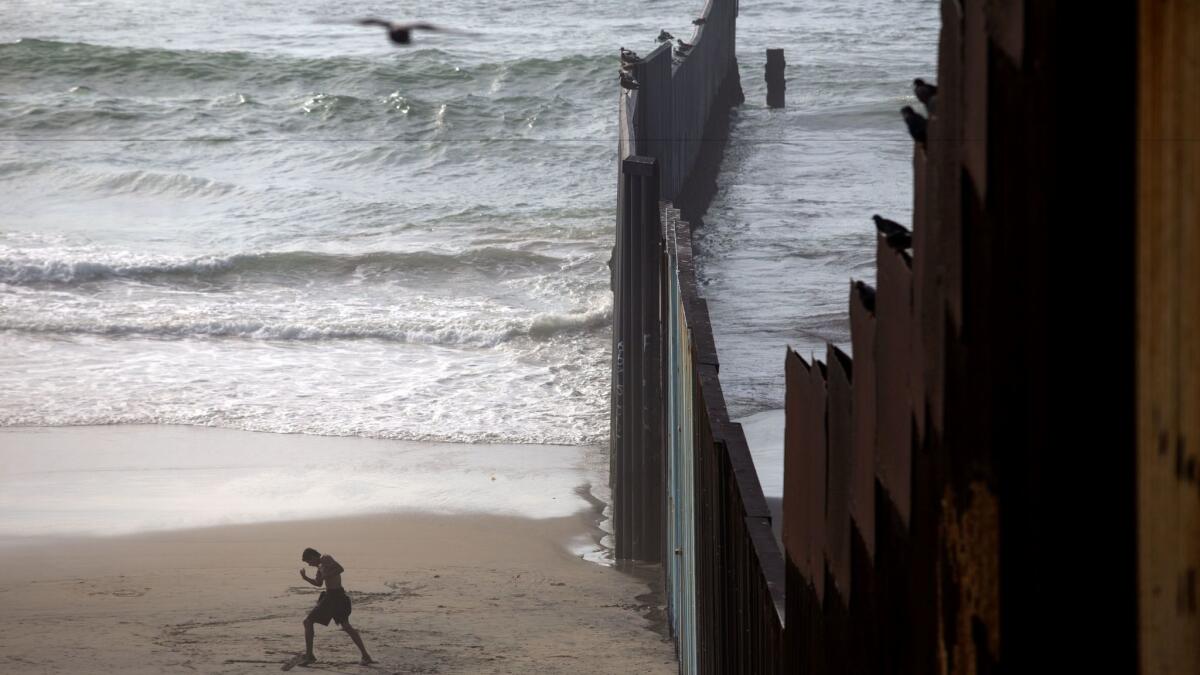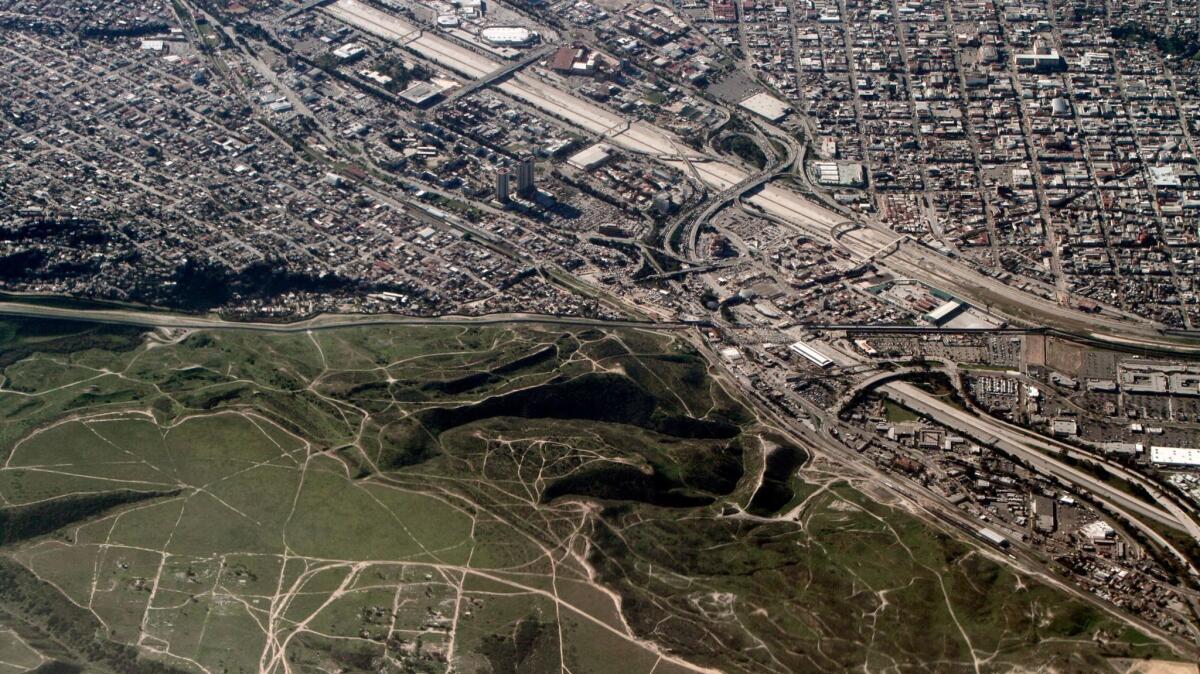Trumpâs border wall may be controversial, but some Southern California firms want to build it

Mexico has said it wonât pay for it. And polls show that the U.S. public doesnât have all that much appetite for it. Nonetheless, the administration of President Trump is moving along with its plans to build a wall along the 2,000-mile U.S.-Mexico border â a project that could end up costing American taxpayers $15 billion to $40 billion (or 101 to 270 times the annual budget for the National Endowment for the Arts).
And even if the funds for the project have yet to be identified â much less authorized â it is a project that is nonetheless entering the design and prototype phase.
Last Friday, the Department of Homeland Security placed a presolicitation notice on the Federal Business Opportunities website for âthe design and build of several prototype wall structures in the vicinity of the United Sates border with Mexico.â The notice says that the department expects to have a formal solicitation online by Monday and concept papers will be due four days later. The plan is to request formal proposals with cost estimates by the end of the month.
Thatâs breakneck speed, especially by government standards â four days to design a prototype that could serve as the model for one of the biggest government infrastructure projects ever.
Even so, in the days since the presolicitation was first posted, more than 300 potential vendors from around the country have signed on. Design writer Kriston Capps of Citylab has analyzed the list, which includes defense contractors, architectural firms and small construction companies of all stripes.
As of Thursday morning, the rundown included about 50 entities from California. Among them was Halbert Construction of El Cajon, near San Diego, which has experience working with the federal government, including projects at the U.S.-Mexico border. The company worked on the pedestrian bridge that connects San Ysidro with Tijuana and built a small stretch of fence around the border station.
Itâs too early to tell what form the wall might take because the government has yet to issue formal specifications for the prototype, says Jimmy Benavente, a project coordinator at Halbert. But, âif itâs going to happen, we would like a piece of it,â he says. âWe try not to bring our political beliefs into it.â
The construction of the U.S.-Mexico border wall is no ordinary infrastructure project. For one, there is its massive scale. Trump wants a âcontiguous, physical wallâ along all 2,000 miles of border with Mexico â which means a whole lot of steel and concrete (not to mention construction jobs).

Itâs a big project, lot of money. We want a piece of the pie.
— Kevin Rouhani, Meridian Precast Inc.
But it faces myriad, possibly insurmountable challenges. Thereâs a 47-year-old treaty with Mexico that dictates that no structure can interfere with the flow of cross-border waterways, such as the Rio Grande. There are also the environmental concerns. A contiguous structure could potentially impact more than 111 endangered species, as well as various wildlife refuges and protected wetlands.
And there are the many political factors.
The border wall remains controversial. At least six in 10 U.S. voters oppose building one, according to a poll released by Quinnipiac University late last month. Rep. Will Hurd (R-Texas), whose district includes 800 miles of U.S.-Mexico border, came out against it. Not to mention the fact that unauthorized immigration to the U.S. has actually declined in recent years.
Moreover, for some in the design community, the wall has raised all kinds of ethical issues. Last year, the architectural website ArchDaily generated an outcry when it announced a competition titled âBuilding the Border Wall?â One architect called for a boycott of the site in response. Others wondered whether the competition encouraged xenophobia. And a lengthy piece in the New Republic explored whether the competition completely missed the point on the borderâs more pressing needs, such as municipal infrastructure for the informal settlements known as colonias.
In his analysis, Capps writes that âany company (or companies) picked for the job faces a sincere reputational risk.â
ââNo Ban, No Wallâ has emerged as a rallying cry for Muslim and Latino communities and their allies at protests held across the nation,â he adds. âThe firm that wins the final [request for proposals] may also earn undesirable exposure from activists.â
Given the fraught nature of the enterprise, I was curious why companies were interested in the contract and what a new wall might look like. (To be certain, the idea of building a wall isnât new. More than 650 miles of border barriers already exist, which have already cost taxpayers around $2.3 billion â or about $3.5 million per mile.)
Some firms were reluctant to talk. One project manager at a small construction company based in Alta Loma told me, âIâm not sure itâs something we really want to engage in.â
Others were intrigued by the question of economics.
Kevin Rouhani of Meridian Precast Inc., a Westwood-based company that produces prefabricated walls and concrete panels and has worked on government infrastructure such as BART stations in the Bay Area, also said it was too early to tell what a wall might look like.
âThere hasnât been anything like it,â he says. But the scale grabbed his eye when the presolicitation went up. âItâs a big project, lot of money. We want a piece of the pie.â
He says tries to âlook pastâ the politics of the wall. âIf itâs going to be done, itâs going to be done, I canât change that.â
Benavente, of Halbert Construction, says, âItâs been a topic since the political race started and, in our office, political beliefs aside, we like to keep our doors open.â
And while itâs too early to talk aesthetics, he notes that ânothing is going to be foolproof.â
âUnless youâre putting a wall thatâs 200 feet tall and a 100 feet underground,â he says, âthere are people who are going to tunnel under or create mobile structures to advance over the top.â
One of the more unusual vendors to appear on the presolicitation list was a small, bicoastal design studio called JuneJuly, founded by architects Jake Matatyaou, who is based in Los Angeles, and Kyle Hovenkotter, in New York. Matatyaou is on the faculty at SCI-Arc, the Southern California Institute of Architecture in downtown Los Angeles; Hovenkotter teaches at Columbia University and the Pratt Institute, among others.
For both, the border is a long-running area of interest.
âWeâre interested in conversations around the future of cities, especially with respect to borders,â says Hovenkotter. âWe think we want to approach this project as honestly as we can.â
In the past, the pair has worked on a conceptual project, titled âApproaching Borders,â that tries to subvert the infrastructure of the border so that it becomes a point of linkage, rather than separation. For example: placing two-way video feeds at points along the wall so that people at the border can connect visually with people in other cities such as Washington, New York and Mexico City â a way of using the tools of surveillance to connect.
Can we come up with something more humane? More aesthetical?
— Jake Matatyaou, JuneJuly design studio
âIf we begin with the fact that weâre building a hard border, something physical and material and that it will be built, we start with the question, âWhat is an aesthetically, humanitarianly minded thing?â asks Matatyaou. âCan it have a more human interface than something that is just technical and tactical and is about demarcation and territorialization?â
Are they concerned about the ethics of working on such a controversial piece of infrastructure?
âHonestly, I take a post-national position,â says Hovenkotter. âI think the nation-state is a kind of outdated construct. And I think they are creating more political problems than solutions. But I also understand that if there is a system in which to play, you might want to play in it and make the best of it.â
Matatyaou concurs.
âWe want to look at a response â to try to develop a response that is not a wall,â he says. âCan we come up with something more humane? More aesthetical?â
Theyâll have four days to figure it out.
To read the article in Spanish, click here
Sign up for our weekly Essential Arts & Culture newsletter Âť
ALSO
What border walls look like around the world
Border walls arenât unheard of, but today they increasingly divide friends, not enemies
You can build a wall â except here, a river runs through it
More to Read
The biggest entertainment stories
Get our big stories about Hollywood, film, television, music, arts, culture and more right in your inbox as soon as they publish.
You may occasionally receive promotional content from the Los Angeles Times.











